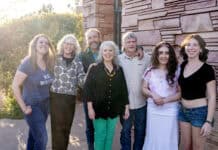Eric Glomski, founder of Page Springs Vineyards in Cornville, gave a talk on the viticultural history of the Verde Valley and the role of Sedona area settler Heinrich “Henry” Schuerman on Thursday, Feb. 13, as part of the Sedona Heritage Museum’s “Sedona Stories” program.
Schuerman, was born in Melle, Germany in 1852 where he trained to be a baker, according to the museum. “To avoid service in the German army, Henry’s family arranged for him to come to the U.S. in 1872. After spending several years in several states, Henry went to Prescott, Arizona Territory, where he worked as a baker and ran a hotel.”
In 1884, Schuerman married Karoline Dorothe “Dorette” Titgemeie, whom he met when they were children in Germany, in New York City after conducting a courtship by correspondence.
“Schuerman was, of course, a German immigrant … and probably the fact that he was a baker was instrumental, because bakers work with yeast and yeast is the thing that creates wine,” Glomski said. “He kind of ended up at Red Rock Crossing because of the debt somebody paid him with land, and he moved down there and he established a homestead.”
The Schuerman Homestead is located south of what is now the intersection of Red Rock Loop Road and Cimarron Ridge Drive.
“The Schuermans were prominent contributors to their new community,” the SHM website states. “They built he first school in the area in 1891, and established the first cemetery in 1893. Henry served as a Yavapai County justice of the peace, served on the local school board, worked building local roads, and the family home was an informal postal drop. Schuerman produce was sold across Arizona. Grapes from their extensive vineyards were made into wine and sold to Jerome miners and local cowboys. Theirs was the first commercial winery in Arizona.”
However, “Arizona, in its infinite wisdom, started prohibition in 1915 five years before it became federal prohibition,” Glomski said.
In May 1917, Schuerman was jailed for selling 100 gallons of wine for $80 but was later pardoned by Gov. Thomas Campbell that December.
The 0.8-acre Schuerman Homestead at 120 Loy Lane was deeded to the Sedona Historical Society in January 2019 by Martha Loy, the granddaughter of the Schuermans, who was raised in the house, and was listed on the National Register of Historic Places on March 10, 2023. The museum has since completed extensive renovations of the homestead, including a new roof, electrical work and stabilizing the foundation and the chimney. The structure is the only remaining local home that was used to meet the requirements of the Homestead Act.
“The Heritage Museum and [Glomski] have worked together for a few years to resuscitate the original Schuerman Zinfandel grape stock, and so Page Springs has a vineyard of vines from that stock … and they’re trying to grow them,” SHM Executive Director Nate Meyers said. “Something that’s on the table is, how can we partner with Page Springs and potentially bring back the Schuerman grapes, back to the land they started on.”
Glomski said that some of Schuerman descendants, including individuals present during the talk, were considering planting an acre of Schuerman’s Zinfandel grapes at the historic homestead.
“I have told everybody, including [SHM], that I’d be willing to volunteer my time and do the fundraising to get the money to plant these vines that we’ve been curating … with the hopes of having one acre,” Glomski said. “Generally speaking, an acre gives you about three tons of grapes. A ton of grapes is about 65 cases. So you get about 200 cases of wine, 2,400 bottles. And that [wine] could be used to fund the restoration of this house and that site.”
“Someday ‘soon,’ Schuerman Zinfandel grapes will be planted at the Homestead House, and the family’s vineyard legacy will continue,” the SHM website states.
Glomski was born in Illinois, but his family relocated to Bedford, Mass., when he was 7, where he credited annual visits to Lexington Common with helping him to acquire a love of history “almost by osmosis.” He attended Northeastern University in Boston before transferring to Prescott College, from which he graduated in 1989 with a degree in riparian ecology and restoration.
While subsequently working on a master’s degree at Northern Arizona University, where he was developing a model linking river restoration to geology and soil composition, Glomski met Prescott artist Richard Landis, who once lived off the grid for a decade making apple wines. Inspired by Landis’ example, Glomski began making his own apple wine from the fruit of trees he found on area homesteads during his research.
“The first wine I made, when I smelled it, reminded me exactly of the place where those apples came from,” Glomski said. “It helped me realize that I was a scientist at the time. I could become an artist … I believe winemakers paint landscapes with liquid, and so that became my passion. And it made sense, because all these different places, with different soils, different ecology, would lead to different wines, even if the grapes were the same.”
The next “Sedona Stories” program will be held on Thursday, March 13, at 10 a.m., when screenwriter, author and actress Dev Ross will discuss “Disney’s First Female Writer.” Ross wrote for several Disney cartoon shows in the 1990s and was the screenwriter of four “The Land Before Time” movies.
For more information about the Schuerman Homestead House, visit sedonamuseum.org/homestead-house.
